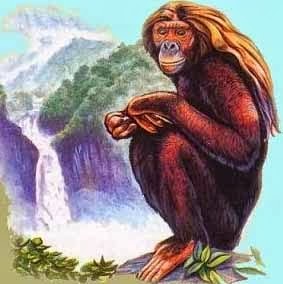Batutut -
The
Batutut or
Ujit or
Người rừng, sometimes also known as "forest people", is a proposed hominid cryptid, reputedly similar to the bigfoot, thought to inhabit the Vũ Quang nature reserve and other wilderness areas of Vietnam, Laos and northern Borneo. The Vũ Quang has been the source of a number of newly discovered mammals by Dr. John MacKinnon. Mackinnon claims to have first observed tracks in 1970 that led him to believe that a hominid similar to the Meganthropus lives there. Mackinnon's 1975 book
In Search Of The Red Ape describes his experiences and findings. A 1947 sighting by a French colonist refers to the animal as a
L'Homme Sauvage (wild man). Vietnamese scholars refer to the animal as the
Người Rừng ("forest man").
 |
| Map of Vu Quang National Park |
It is described as being approximately 1.8 m (6 ft) tall and covered with hair except in the knees, the soles of the feet, the hands, and the face. The hair ranges in color from gray to brown to black. The creature walks on two legs and has been reported both solitary and moving in small groups. The creature is most often sighted foraging for food from fruits and leaves to langers and even flying foxes.
In Borneo, witnesses describe it as four feet tall and very aggressive, occasionally killing humans and tearing out their livers.
Ccryptozoologist Loren Coleman believes that the Batutut are a surviving population of Homo erectus or Neanderthal and this could be possible. The Vũ Quang and wilderness of Vietnam is rather large and still somewhat unexplored.
Sightings -
In his book
Very Crazy G.I. - Strange but True Stories of the Vietnam War, Kregg P. J. Jorgenson relates a sighting of such a creature by a team of US soldiers. The men referred to it as a "Rock Ape" reporting it as being small in stature, about 5 feet tall and having a reddish tinge to its fur.
Two Người Rừngs were reportedly captured by tribesmen near Dak Lak Province in 1971. In 1974 a North Vietnamese general, Hoang Minh Thao, requested an expedition to find evidence of the creatures, but it was unsuccessful.
In 1918 a hunter, Mr. Van Heerwarden found some odd human type tracks but never seen what or who made them. In 1923, Mr. Van Heerwarden found these human type tracks again and followed them. He followed the prints until he spotted a wild man in a tree: "I discovered a dark and hairy creature on a branch. ... The sedapa was also hairy on the front of its body; the colour there was a little lighter than on the back. The very dark hair on its head fell to just below the shoulder-blades or even almost to the waist....Had it been standing, its arms would have reached to a little above its knees; they were therefore long, but its legs seemed to me rather short. I did not see its feet, but I did see some toes which were shaped in a very normal manner. ... There was nothing repulsive or ugly about its face, nor was it at all apelike". The above quote is from
Abominable Snowmen, by Ivan T. Sanderson. Abominable Snowmen is available on Kindle - get it now by
Clicking Here!
More recently the now canceled TV show Destination Truth made a trip to look for Batutut. Josh Gates and his team went to Vietnam and found large human type footprints and also managed to filmed a possible Batutut with a thermal imager.
Here is a clip of it.
Gates and his team made a casting of the humanlike tracks and took them to be examined by noted Bigfoot researcher, anthropologist Jeff Meldrum. Meldrum called the print "a significant discovery" and one of the best pieces of evidence he had seen.
With all the similarities to Bigfoot it is not surprising that the Batutut is sometimes called the Bigfoot of Vietnam but I find the Batutut to also be similar to the orang-pendek.
While putting together this post from various sources and adding in some of my own thoughts, I was surprised at some of the information I found. One thing I found rather interesting is that the overall size of reports of this creature falls well within the range of human sizes. I could not find any reports stating that the creature was over 6 foot tall or a hulking 10 foot beast. It makes me wonder if this is maybe just a scientifically undocumented monkey species of some sort. A little over one year ago a new spices of monkey was discovered in the Congo. The Lesula was the first new monkey species discovered in 28 years. It has a strikingly large, almost human like face with human type eyes and a pink face.
So could the Batutut be just another yet to be documented monkey species? possibly, then we can also question what is bigfoot? Monkey, Ape, lost man, hybrid or maybe we should just call most of them Primates at this point. It would seem more fitting.
Primates are grouped into monkeys, apes and hominids. Most monkey species have tails, but this is not true for apes or hominids, as they do not have tails, so until we can find out more about these creatures maybe Primate is a good name for now. If we consider the above primate information, we can deduce that Bigfoot would most likely fall within the apes or hominids area, which causes debates in the bigfoot community. I have never heard of any reports of bigfoot having a tail. Just remember this is a broad approach and each groups has groupings and characteristics that need to be considered. So in the end much more study and research will have to be done not only on the Batutut but our beloved Bigfoot.
Thanks
~Tom~
[Sources: cryptozoo-oscity, Wikipedia ]
This post sponsored in part by

(Interested in sponsoring a story? then send us an Email!)












































